The Complete Checklist for Winterizing Your Boat (Free PDF)
More than twenty years ago, when I bought my first boat, I didn't have a clue about a lot of things. As the first sailing season was winding down, a friend asked me about my plans for "winterizing" the boat.
I'm sure my dumb look was priceless. As a new boat owner, I'd been more concerned with figuring out which lines went where and how to get in and out of a slip with all my gel coat intact than any thoughts for the winter.
Winterizing a boat means securing every system on the boat against freezing, corrosion, and damage from cold while preparing the boat for layup and disuse.
📋 Download your free boat winterization checklist here
Systems get drained, flushed, and filled with antifreeze; the boat gets covered and protected from snow and ice; and engines and mechanical systems are cleaned, lubricated, and stored so they start up again easily in the spring.
Sounds like a lot of work, right? It can be, but it depends on the size of your boat. A large boat with multiple complex systems will take some time, but a simple day sailor with an outboard can be done in an afternoon.


Interactive Checklist of Winterizing Steps and Supplies
It's not complex, you just need to know what to do for the specific systems on your boat. This is more of a checklist than a detailed step-by-step guide, so you understand what you're getting into and what needs to be done.
- Winterizing your boat includes draining all water from the boat, adding antifreeze to the engine and plumbing systems, and removing all electronics and batteries.
Fill up your fuel tanks and add a fuel stabilizer to prevent the fuel from degrading over the winter. Run the engine for a few minutes to circulate the stabilized fuel throughout the system.
- Clean and dry your sails thoroughly before storing them. Remove any stains or mildew with a sail cleaner. Fold the sails carefully and store them in a dry, cool place.
- Clean the hull and remove any marine growth, such as barnacles or algae. Apply a coat of wax or polish to protect the hull from the elements. Cover the boat with a breathable cover to prevent moisture buildup.
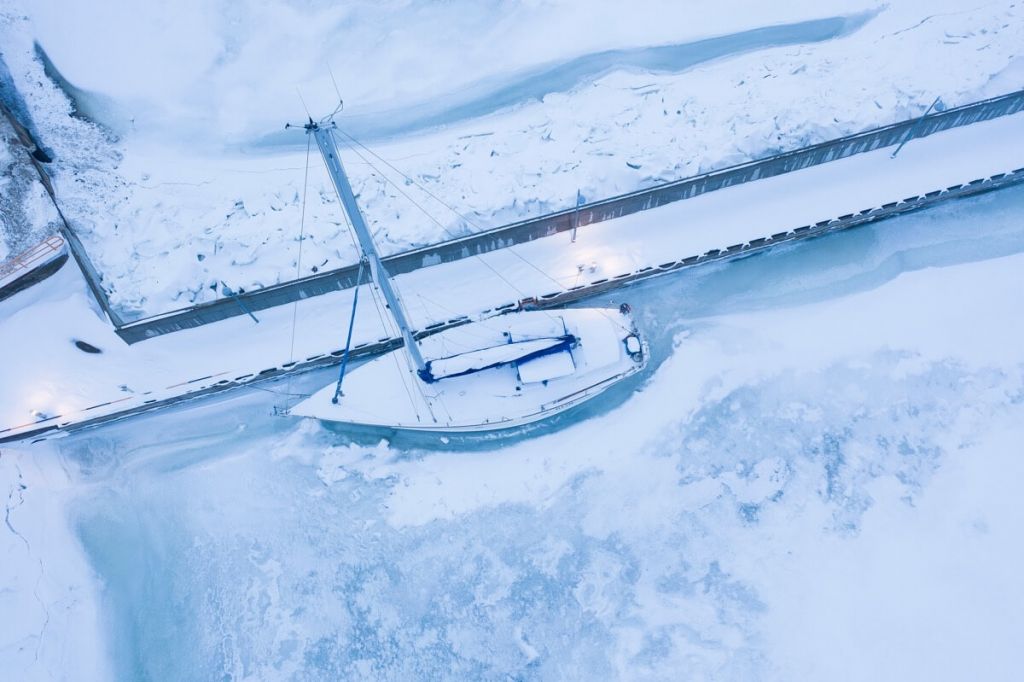
On this page:
Boat winterization checklist, winterizing specific parts of your boat, store the boat.
It's important for boat owners like you to carefully follow a comprehensive winterization checklist and ensure that all necessary steps are taken to properly protect the boat from winter weather damage.
Drain all water from the boat , including the fresh water and holding tanks, as well as the bilge. Be sure to open all faucets and valves to allow all water to drain out.
Add non-toxic Propylene Glycol antifreeze to the engine and plumbing systems to prevent freezing and corrosion. Be sure to follow the manufacturer's instructions for the correct amount to use.
Remove all electronics and batteries from the boat and store them in a dry, cool place. This can help prevent damage from moisture and extreme temperatures.
Clean the hull and remove any marine growth, such as barnacles or algae. Apply a coat of wax or polish to protect the hull from the elements.
Cover the boat with a breathable cover to prevent moisture buildup. Be sure to secure the cover in place to prevent it from coming loose during high winds.
If you plan to leave the boat in the water, install a de-icer to prevent ice from forming around the boat and damaging the hull.
Consider using a dehumidifier or moisture absorber in the cabin to prevent mold and mildew from forming over the winter.
Inspect all safety equipment , such as life jackets, flares, fire extinguishers, and first aid kits. Replace any expired or damaged items.
Check all ropes, lines, and rigging for wear and tear. Replace any damaged or worn out components.
Remove any valuables or items that may be damaged by moisture or extreme temperatures.
Secure the boat to its mooring or trailer and ensure that it is properly supported.
Consider having a professional mechanic or boatyard perform a full winterization service to ensure that your boat is properly prepared for the winter season.
Make sure that you have adequate insurance coverage for your boat over the winter months.
Sailboat winterization checklist
Here's are the specific checks for sailboats:
Clean and dry the sails thoroughly before storing them. Remove any stains or mildew with a sail cleaner. Fold the sails carefully and store them in a dry, cool place.
Remove the mast and store it separately in a dry, cool place. Inspect the mast for any damage or wear and replace any worn or damaged components.
Supplies you may need
Your specific needs for winterizing will vary with the systems on your boat and the type of engine and fuel you have and the type of storage you choose. Quantities will vary with the size and complexity of your systems.
- Non-toxic Propylene Glycol antifreeze - the "Pink Stuff" (water systems, engine, bilge) for -50F protection, or -100F for colder climes (usually green or blue). Do not use Ethylene Glycol or auto-anti-freeze for winterizing. It is highly toxic to you and to marine life.
- Engine oil and filter (engine)
- Fogging oil (engine)
- Fuel stabilizer/biocide (engine)
- Antifreeze Hydrometer or "antifreeze tester" (engine)
- A cover - shrink wrap, tarps, a canvas cover, or indoor storage
- Dehumidifying agent or dehumidifier/heater (cabin)

Do You Have to Use Antifreeze to Winterize a Boat?
The engine and generator.
The task for all engines is similar, though the specific steps vary.
- Rinse and flush the engine with freshwater to remove salt.
- "Fog" the engine with a spray oil.
- Flush antifreeze through the engine.
- Change the oil and oil filter.
- Change fuel filters.
- Close through hulls on intakes and fill strainers with antifreeze.
Inboard engines
Freshwater cooled inboard engines have a few more steps for safety.
- Check antifreeze level in the engine block with a tester and add anti-freeze as needed to maximize cold protection. Make sure you circulate the new mix before re-testing.
- Flush and fill the engine and lines with antifreeze.
You also have to winterize the outboard motor. Here's how:
- With the engine running, disconnect the fuel line and run the engine until it stops. This empties all the fuel from the carburetor.
- Change lower unit oil.
Learn more about what happens to your engine if you don't winterize your boat here .
Marine diesel winterization checklist
If you have a marine diesel engine, it's important to follow this checklist that includes changing the oil and oil filter, adding a fuel stabilizer, and draining all water from the engine.
Check the manufacturer's recommendations for the proper temperature range for your diesel engine . Diesel fuel can begin to gel or solidify at temperatures below 32°F (0°C ), which can cause damage to the engine.
Drain the antifreeze and coolant from the engine and replace it with a non-toxic Propylene Glycol antifreeze to prevent freezing and corrosion. Be sure to follow the manufacturer's instructions for the correct amount to use.
Change the oil and oil filter before storing the boat for the winter. This can help prevent moisture buildup and corrosion in the engine.
Add a fuel stabilizer to the fuel tank to prevent the fuel from degrading over the winter. Be sure to follow the manufacturer's instructions for the correct amount to use.
Run the engine for 10-15 minutes to circulate the stabilized fuel throughout the system.
Drain all water from the engine , including the fresh water and raw water cooling systems, as well as the heat exchanger. Be sure to follow the manufacturer's instructions for the proper method of draining the water.
Replace the raw water impeller to prevent it from becoming brittle over the winter. This can help ensure that the engine is ready to go when boating season starts up again in the spring.
Replace the fuel filter to prevent any contaminants from building up in the fuel system over the winter.
Add a biocide to the fuel tank to prevent algae growth. Be sure to follow the manufacturer's instructions for the correct amount to use.
Fill up the fuel tank to prevent condensation buildup. This can help prevent moisture from building up in the fuel tank over the winter.
Remove the engine's zinc anodes and replace them with new ones before storing the boat for the winter. This can help protect the engine from corrosion.
Cover the engine with a breathable cover to prevent moisture buildup. Be sure to secure the cover in place to prevent it from coming loose during high winds.
Fuel systems
Diesel fuel.
- Add a biocide/stabilizer to the fuel tank.
- Fill the tank after you add the stabilizer.
Most gasoline outboards use a removable tank. This fuel should be disposed of properly or used for some other purpose, so you start with a fresh tank in the spring. (I used to put my leftover dinghy fuel into my car.)
If you have an older boat with a gasoline inboard and a permanent tank installed, you can drain it, or add a stabilizer and fill it.
Plumbing systems
Pressure (fresh) water.
- Flush all tanks and lines.
- Add antifreeze to the water tank.
- Run all fixtures until antifreeze runs out, starting with the fixtures farthest from the pump.
Water heaters
- Drain all water.
- If there is a winterizing bypass, shut it off before winterizing the pressure water system so you don't have to fill the tank with expensive antifreeze.
- Disconnect the electricity or turn off the breaker to prevent accidental startup in the spring while it's empty.
Heads and toilets
- Flush all toilets with fresh water
- Pump out and rinse all holding tanks.
- Using the water intake hose, flush the system through with antifreeze
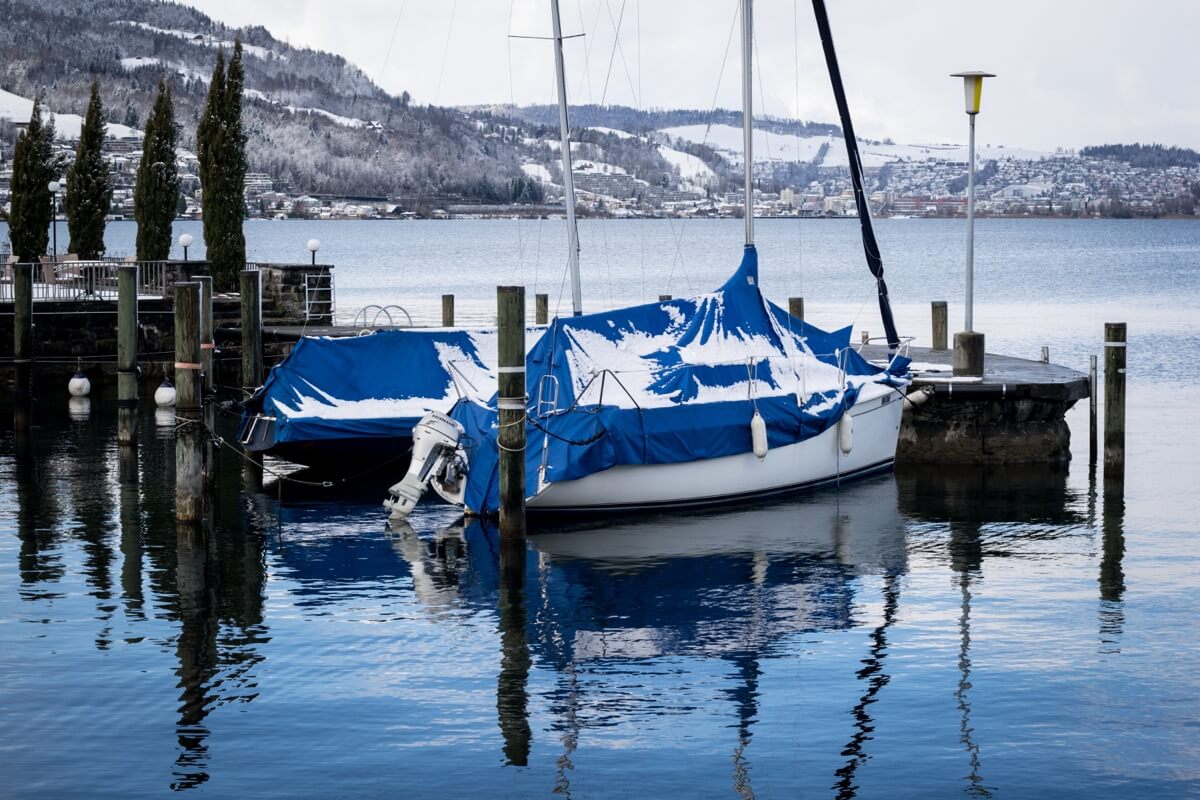
Refrigeration
- Flush all raw water lines with antifreeze
- Pump or drain the bilge into a proper receptacle.
- Add antifreeze to cover exposed pumps or through hulls
- Run the pump briefly and fill it with antifreeze.
Most boats in seasonal cruising regions are still using Lead-Acid batteries - either flooded (wet) cells, AGM, or Gel. There are minimal differences between lead-acid types when winterizing, but LiFePO~4~ banks require different long term layup care.
- For wet cells, top up all cells as per manufacturer's instructions (usually with distilled water).
- Fully charge all batteries.
- Disconnect electrical connections from the boat.
- If practical for smaller batteries, remove them and store them indoors with a trickle charger.
Lithium (LiFePO~4~)
Consult your manuals for details on longer term layup instructions and periods of disuse. LiFePO~4~ technology is fairly new, and manufacturer recommendations should be followed when available.
- Charge/Discharge to 50% state of charge or the manufacturer's recommended storage voltage.
- Disconnect all connections from the boat.
Air conditioning
- Flush and fill raw water lines with antifreeze.
Water maker
Be sure to read the manual and follow all the steps in order. Sending pressurized antifreeze through your membrane can damage it.
- Pickle membrane with preservative as per manufacturer's instructions.
- Flush raw water intake systems with antifreeze.
- Replace or remove all filters.
Covering, ventilation and moisture
Boat covers.
Boats stored outdoors in places with freezing temperatures should be covered. While a detailed discussion about boat coverings and types of covers is beyond the scope of this article, you should be aware that there are multiple options.
- Canvas covers: Expensive up front, but reusable from season to season and the best environmentally and for the boat.
- Shrink wrapping: An annual expense that you may want to leave to the pros to do. Should be recycled in the spring.
- Tarps and improvised materials: Smaller boats can be covered with tarps and other inexpensive materials, but they are prone to blowing off and coming loose. Tarps are difficult to secure on wet-stored boats since you can’t get lines under the hull easily.
Boat winter covers can cost anywhere between $200 and $800, tarps are roughly $20 to $200, and shrink wraps are $10 to $20 per foot.
Ventilation and moisture
Stagnant air and trapped moisture are the leading causes of mold and mildew growth on boats in the winter.
- Make sure any boat covers have leak-proof ventilation and allow airflow.
- Open all cabinets and storage areas, empty lockers where airflow is restricted.
- Remove mildew prone items such as towels and clothing for the season and store them off the boat.
- Consider chemical desiccants, a fan, a winter cabin heater, and/or a dehumidifier.
- If security permits, leave some windows or a hatch open under the cover.
- Rinse and sails with fresh water and allow to dry prior to flaking.
- Take any sails in need of repairs to a sail loft.
- Consider annual inspection, cleaning, and winter storage with a sailmaker to extend sail life.
The real cost of winterizing your boat on a budget ranges from $1,020 to $2,025, depending on the size of your boat.
You must make arrangements well in advance for a place to store the boat for the winter. Considerations of budget, local climate, and geography will drive this, and each storage method has advantages and disadvantages.
Boat winter storage checklist
Choose a storage location that is dry, cool, and secure. This could be a garage, storage facility, or marina.
Clean and dry the boat thoroughly before storing it. This includes the hull, deck, and all interior spaces.
Choose a boat cover or shrink wrap to protect the boat from the elements. A boat cover can be made from a variety of materials, such as canvas, polyester, or vinyl. Choose a cover that is breathable to prevent moisture buildup.
If you're on a budget, consider using a tarp to cover the boat instead of a custom-made cover. However, be sure to secure the tarp in place to prevent it from coming loose during high winds.
If you have a sailboat, consider using a cheaper and quicker method for winterizing your boat, such as removing the mast and storing it separately .
Install a dehumidifier or moisture absorber in the storage space to prevent mold and mildew from forming over the winter.
Check on the boat periodically throughout the winter to ensure that the cover or shrink wrap is secure and that there are no signs of damage or moisture buildup.
Hard stands/dry storage
Dry storage is most common in colder areas where salt water may freeze. Your boat can't sink on the hard, and it will be available to work on, though you'll need a ladder.
Taking the rig down for the winter is usually not required, but it will afford the opportunity to inspect and service the rig in the off season and reduces windage if you store in a storm prone area.
In-water storage
In-water storage is a good budget alternative, but it needs different steps.
- Keep bilge connected to a battery.
- Keep batteries charged for bilge pumps.
- You may want "Ice Eaters" in the slipe for areas prone to freezing.
Trailered boats are easy and cheap to store if you've got space. Be sure to still cover the boat and winterize systems unless you're storing it indoors.
Indoor storage
Indoor storage removes the need for a cover, but will usually require mast removal. Take care to still winterize systems if your storage building is not heated.

Do I Need to Winterize an Indoor Stored Boat?
You can winterize your boat by doing it yourself for $100, or you may opt for professional winterization services that cost up to $700.
Visit your boat
"Out of sight, out of mind" is a common problem with winter storage. Except for violent storms, most winter storage damage doesn't happen quickly. It's the result of creeping effects, like water seeping in and freezing, mold growing in damp, stagnant spaces, or heavy weights of snow and ice pressing on covers and breaking them.
So make the time in the winter to check your boat now and then. After a snow or big freezing rain storm, check for accumulation on the cover and leaks and incursions. Nip problems in the bud. When you open up a clean boat that smells nice in the spring, you'll forget that cold day in February when you swept the snow off the shrink wrap.
The best prevention in the fall won't help you if something goes wrong and unchecked for the rest of the winter.
If you were not able to do the winterization process, it can lead to costly damage to the boat and its components. Here's what you can do now.
Leave a comment
You may also like, how long does it take to winterize a boat on average.
Winterizing a boat involves a series of steps that are designed to protect your boat from the harsh winter weather and prevent damage to its various systems. It …

How to Winterize Your Sailboat Cheaper & Quicker
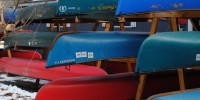
The Real Cost to Winterize Your Boat on a Budget
- New Sailboats
- Sailboats 21-30ft
- Sailboats 31-35ft
- Sailboats 36-40ft
- Sailboats Over 40ft
- Sailboats Under 21feet
- used_sailboats
- Apps and Computer Programs
- Communications
- Fishfinders
- Handheld Electronics
- Plotters MFDS Rradar
- Wind, Speed & Depth Instruments
- Anchoring Mooring
- Running Rigging
- Sails Canvas
- Standing Rigging
- Diesel Engines
- Off Grid Energy
- Cleaning Waxing
- DIY Projects
- Repair, Tools & Materials
- Spare Parts
- Tools & Gadgets
- Cabin Comfort
- Ventilation
- Footwear Apparel
- Foul Weather Gear
- Mailport & PS Advisor
- Inside Practical Sailor Blog
- Activate My Web Access
- Reset Password
- Customer Service

- Free Newsletter

Island Packet 350 Used Boat Review

Beneteau 393 Used Boat Review

The PDQ 32 Cruising Cat Used Boat Review

Dufour 44 Used Boat Review

How to Create a Bullet-Proof VHF/SSB Backup

Tips From A First “Sail” on the ICW

Tillerpilot Tips and Safety Cautions

Best Crimpers and Strippers for Fixing Marine Electrical Connectors

Superlight Anchors: Not Just for Racers

Refining Furling Line Fairleads
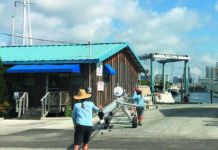
Revive Your Mast Like a Pro

Solving the Dodger Dilemma

Diesel-Electric Hybrids Vs. Electric: Sailing’s Auxiliary Power Future

Sailing Triteia: Budget Bluewater Cruising

How To Keep Pipe Fittings Dry: Sealant and Teflon Tape Tests

What’s The Best Bottom Paint?

Boat Hook and Fender Hacks
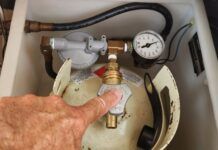
Propane Leak: How to Detect, Locate and Fix

Product Hacks: Velcro, Bounce, Anti-Skid Mats and Pool Lights

Stopping Holding-tank Odors

Giving Bugs the Big Goodbye

Galley Gadgets for the Cruising Sailor

Cold Weather Clothes to Extend the Sailing Season

Five Best Gloves: Sailing and DIYing in All Weather

Sailing Gear for Kids

What’s the Best Sunscreen?


R. Tucker Thompson Tall Ship Youth Voyage

On Watch: This 60-Year-Old Hinckley Pilot 35 is Also a Working…

On Watch: America’s Cup

On Watch: All Eyes on Europe Sail Racing

Dear Readers
- Inside Practical Sailor
Is Your Marine Diesel Winterizing Routine Complete?
Dealing with coolant, fuel, and lubrication are just a start..

Winterizing an inboard engine installation means a lot more than filling the cooling system with antifreeze and stuffing a rag in the exhaust outlet. It means taking care of the exhaust system, the fuel system, the engine controls, and other components of the drive train, such as the shaft and prop. If you want to do these things yourself — none of them is difficult, only time consuming — plan on a long day of work, or perhaps a leisurely weekend.
It’s work that will pay off, however, both in improved understanding of your boat’s propulsion system, and in money saved. At $25 per hour, the simple projects described here will save you about $200. Few special tools are required, and the only skill necessary is a modicum of common sense.
While many items of drive train maintenance can be done as easily in the spring as in the fall, the rush to get the boat back in commission frequently means that some items fall to the bottom of the priority list, and may never get done. Most sailors sadly neglect their boat’s mechanical components, sometimes with somewhat self-righteous claims that sailors don’t really need to know such stuff. Invariably, these are the folks whose auxiliaries die with less than a thousand hours on them, and whose gearboxes and shift linkages fail when they’re docking (When do you think your shift linkage is going to seize — when you’re traveling ahead in a straight line at six knots?)
Fuel System
The first component of the drive system to be attended to is the fuel system. Whether you have a diesel engine or a gas engine, a fuel additive can be used to stabilize the fuel during the storage period, even if it is only a month or so.
Diesel and gasoline stabilizers are not interchangeable. Diesel additives usually have biocides to prevent the growth of system-clogging organisms in the fuel.
As obvious as it may sound, read the instructions before buying a fuel stabilizer. Some require draining the tank before treatment, others require adding fuel to the tank after treatment, and some can just be dumped into a full tank.
In any case, it is important to run the engine for 10 minutes or so after treating the fuel, so that the additive gets into the fuel lines and filters, the carburetor of a gas engine, or the injectors of a diesel engine.
If the boat is already on land when you go through the winterizing process, run a water hose to the raw water intake to provide engine cooling water. Most engine intakes are smaller than the plastic or metal end fitting on the hose. A 6′ length of hose with a female fitting can simply be screwed onto the mainwater hose, and the end of the short hose (with no fitting) jammed into the raw water intake. Someone should keep an eye on the hose while the engine is running just to make sure it doesn’t pop out.
Fuel filters can also be changed at this time. A strainer-type gasoline filter should be cleaned — out of doors — with fresh gasoline to remove sediment, and the bowl of the filter should be drained.
Likewise, it is important to drain the water from a diesel separator, particularly on a boat laid up in a cold climate. Filter elements can be changed at this time.
If filters and separators are taken care of before treating fuel, they will become filled with stabilized fuel when the engine is run.
There are two schools of thought about storing fuel in the tanks when the boat is laid up. In the past, with gasoline systems using copper tanks and copper fuel lines, the practice was usually to drain the system for the winter to prevent the formation of gum. With modern gasoline and stabilizers, this problem is minimized, and the tanks will fare well if left full.
Opinion about the condition of diesel tanks during varies. It is true that during suspended sediment in diesel fuel will settle out on the bottom of the tank. This sediment could perhaps be a problem next season, if you were sailing in very rough conditions with very little fuel in the tank. The sediment could be stirred up, resulting in badly contaminated fuel. That, of course, is why you should have two filters in your diesel fuel system.
At the same time, an empty or almost empty metal fuel tank in a boat laid up in a cold climate can generate a lot of condensation. If you have a black iron diesel fuel tank, the condensation can accelerate corrosion. The safest course is to keep the fuel tank full on any boat having metal tanks.
Fiberglass tanks present another set of problems. Although the typical orthophthalic resin used in building is highly resistant to chemicals, it is not perfectly resistant. Isophthalic resins offer considerably more resistance to attack by chemicals, and are therefore preferable for use in fuel tanks. Unfortunately, relatively few builders use isophthalic resins because of the additional cost. If you have fiberglass fuel tanks, and are unsure of the resin used in their construction, it would be prudent to lay up the boat with the tanks empty.
With the engine still warm from running treated fuel through the system, change the crankcase oil. Unless your engine has a built-in crankcase pump, you’ll have to pump the oil out through the dipstick hole.
You can either use a manual pump such as the Par Handy Boy, or any one of a number of small impeller pumps designed to fit in the chuck of a 1/4” drill. The drill-driven pumps are quicker, and are frequently easier to use in the crowded engine compartment. However, some of them use a rubber impeller which is not designed to run dry, so that they can have a short life if the pump doesn’t prime quickly.
After draining the oil, change the oil filter element if the engine is equipped with a spin-on filter. Fill the engine with fresh oil.
It is particularly important to change the oil when laying up a diesel engine. Most diesel fuel contains sulfur in varying amounts. A byproduct of the combustion of diesel fuel which contains sulfur is sulfuric acid, which over time will do distressing things to the inside of your engine.
If your transmission is lubricated separately from the engine, check the fluid level. Plan on changing transmission fluid every other year, at least, or once a year on a boat whose engine gets more than about 50 hours of use per year. It’s impossible to change engine oil and transmission fluid too frequently.
The engine’s cooling system must also be winterized. With a fresh water cooled engine, check the fluid level in the coolant tank, topping up with a 50-50 mixture of water and antifreeze if necessary.
The next step is basically the same for both raw water and fresh water cooled engines. The raw cooling water must be replaced with a 50-50 mix of water and antifreeze. The method varies depending on whether the engine is decommissioned while the boat is in the water, or after it has been hauled.
If the boat is still in the water, shut off the raw water intake and remove the hose from the intake seacock tailpiece. Fill a clean bucket with a 50-50 antifreeze mixture. Dip the water inlet hose into the bucket of antifreeze.
Now a little coordination is required. You want to start the engine and run it long enough to make sure that the antifreeze mixture has filled the cooling system, including the muffler. You’ll know you’ve done this when the cooling water ejected through the exhaust is the color of your antifreeze mixture.
At the same time, you don’t want to run the engine after you’ve sucked up the entire bucket of antifreeze. You want the raw water system to be full of antifreeze, not empty. It will take two people: one to hold the hose in the bucket, and one to operate the engine and watch the exhaust. Obviously, a positive means of communication between the two persons involved is also required. Your voice may not travel to the helm from belowdecks (“Shut off the engine.” “What?” “Shut off the engine!” “I can’t hear you.” “SHUT OFF THE DAMN ENGINE!“), but it’s guaranteed to travel across the boatyard.
If the engine is laid up with the boat ashore, you can feed the antifreeze mixture directly through the raw water intake on the outside of the hull using the hose you made up for running the engine prior to changing the oil.
Don’t try to save time by running the engine only once to circulate treated fuel, heat up the oil for changing, and suck up antifreeze. You probably need about 10 minutes of engine running for winterizing the fuel system and warming up the oil. Sucking up antifreeze will probably take a minute or less. At about $5 per gallon, you don’t want to waste too much antifreeze.
A gallon of antifreeze -two gallons of 50-50 mix should handle engines up to about 40 horsepower. Then add extra for hoses. The length of run of the raw water discharge hose to the muffler is as much a determinant of the amount of antifreeze used as is the size of the engine.
When you shut down the engine after winterizing, remove the ignition key and spray the inside of the switch with a lubricant like WD-40 or CRC.
Exhaust System
If you have pumped enough antifreeze through your engine so that the discharged cooling water looks exactly like the antifreeze mixture in the bucket, your waterlift muffler should be well protected. If you want to be supercautious, install a drain plug in the muffler and drain it when laying up the engine. Reinstall the plug immediately after draining so you don’t have to worry about it in the spring. The same goes for any other drain plugs in your system that you remove. Reinstall them now, not later.
Shaft and Prop
Haul out time is the proper time to check the condition of the prop, shaft, cutless bearing, and stuffing box. On a boat that is laid up ashore for the winter months, you can save yourself a fair amount of effort in the spring by doing these tasks when your other drive system layup is done.
First, check the prop for damage and corrosion. Pitting of the blades or discoloration may indicate an electrolysis problem which should be tracked down over the winter.
Wiggle the prop shaft in the cutless bearing. There should be no slop, only the yielding of the rubber against the metal shaft. If the rubber bearing is worn, get a replacement now, rather than waiting until spring. Cutless bearing replacement has the nasty habit of becoming a real project, as the bearing shell frequently seizes in the strut, and must be sawn out or punched out.
This is also a good time to check the shaft for wear. Disconnect the shaft flange at the transmission, and pull the shaft out far enough to see the surface of the shaft where it normally sits in the stuffing box and cutless bearing. A shaft which is worn at the stuffing box may be very hard to seal. Tightening the stuffing box to overcome leaking around a worn shaft will only aggravate the problem. Winter is the time to deal with these projects, rather than the spring, when your primary concern is getting the boat back in commission.
If you have a folding prop, check the blades for slop at the pivot pin. Unless the pin fit is tight, wear will increase, not only in the prop blades but at the cutless bearing and stuffing box. A machine shop can bush the hole in the blades for the pivot pin, restoring a tight fit, and you can easily replace the pin if necessary. If you try to get this done in the spring, you’ll find everyone too busy to help you.
Don’t try to check engine and shaft alignment with the boat out of the water. This is particularly true with a flat bottom, fin keel boat. The weight of the hull on the keel can easily affect engine alignment.
In fact, if you have a fin keel boat with the engine sitting in the middle of the boat, it would be prudent to disconnect the shaft before the boat is hauled, to minimize the possibility of damage.
Engine Controls
On a boat used in salt water, there’s a good chance that the shift and throttle controls have ingested a fair amount of salt over the course of the season. You may want to disassemble the control levers, clean them with fresh water, and give them a dose of spray lubricant.
This is particularly true with controls using pot metal or aluminum components. A surprising number of engine controls use galvanically incompatible materials -notably pot metal castings -which turn to powder in a few years of use in salt water if cleaning and lubricating are not done religiously.
On controls mounted in the cockpit well, check the back side of the mechanism to make sure that it is still well greased.
It takes a fair amount of discipline to tackle the jobs associated with laying up an engine system, particularly when your primary interest is putting the boat away for a while, not fussing with it. However, this is true preventive maintenance, and it will pay off with reduced replacement and maintenance costs, as well as more reliable operation of the drive system.
Laying up your engine will give you more practical knowledge about the operation of things mechanical than a lifetime of just turning the key and pushing the levers. Doing it yourself can help you spot potential trouble before it interrupts your sailing season. The first step toward making your boat a better boat is learning what makes it tick, and the best way to learn that is to roll up your sleeves and get busy.
RELATED ARTICLES MORE FROM AUTHOR
On watch: this 60-year-old hinckley pilot 35 is also a working girl, leave a reply cancel reply.
Log in to leave a comment
Latest Videos

Jeanneau’s New Rule Breaking Sailboat – Sun Odyssey 350 Boat Review

A Fiberglass Cleaning Boat Hack You Have To Try!

X Yachts X43 Sailboat Tour

Truth About Grease – Boat Maintenance Must Do Tips
Latest sailboat review.

- Privacy Policy
- Do Not Sell My Personal Information
- Online Account Activation
- Privacy Manager
- 2024 BOAT BUYERS GUIDE
- Email Newsletters
- Boat of the Year
- 2024 Freshwater Boat and Gear Buyers Guide
- 2024 Boat Buyers Guide
- 2024 Water Sports Boat Buyers Guide
- 2024 Pontoon Boat Buyers Guide
- Cruising Boats
- Pontoon Boats
- Fishing Boats
- Personal Watercraft
- Water Sports
- Boat Walkthroughs
- What To Look For
- Watersports Favorites Spring 2022
- Boating Lab
- Boating Safety
- Ultimate Boating Giveaway

Cheat Sheet on How to Winterize Your Boat
- By Randy Vance
- Updated: January 21, 2021
Too many boats die silently in their winter beds. But follow these easy tips, and your boat will be ready and eager to go in the spring.
Fuel Treatment
Treat your boat’s fuel with a stabilizer. Pennzoil Fuel Stabilizer, PRI-G and Stabil are ideal products for this job. After adding it to the fuel, run the engine for 10 minutes or so to be sure stabilized fuel circulates throughout the engine. If you don’t stabilize the fuel, carburetors and fuel injectors can be clogged with varnish deposits that ruin fuel systems. Cost if you do: $5 to $10. Cost if you don’t: $250 to $1,200.
Fog the Engine Cylinders
Aerosol fogging solutions coat the inside of the engine to protect it until spring. Each engine manufacturer makes proprietary products they promote as ideal for their engines. Hook “ear muffs” and a garden hose to the engine, start it, and then spray the fogging-solution lubricant directly into the air intake until it’s gone. If you don’t fog the engine cylinders, corrosion can form inside the engine, covering the cylinders, pistons and rings with a patina of abrasive crud. Cost if you do: $5 to $15. Cost if you don’t: $2,500 to $15,000 (or more).
Drain the Engine (for inboards and stern-drives)
Locate and open the petcocks (some engines have bronze plugs similar to bilge plugs) underneath the manifolds and on the sides of the engine block. Remove the water-pump hose from the bottom of the water pump to let it drain completely. If you don’t drain the engine, water in the cooling chambers can freeze, expand and crack the engine block and manifolds. Tip: Newer MerCruiser stern-drives have handy drainage systems with one drain plug near the front of the engine. Outboards self-drain and never require this step. Cost if you do: $0. Cost if you don’t: $5,000 to $20,000.
Change the Oil
Change engine oil to eliminate moisture and prevent corrosion. If you don’t, moisture can cause excessive wear, which can lead to loss of power, poor fuel economy and possible engine failure. Tip: Some mechanics change the oil both in the fall and at spring breakout on the theory that the engine oil needs to be changed at the end of the summer and after suffering the ravages of winter because moisture may again accumulate in the oil. Cost if you do: $30 to $75. Cost if you don’t: $500 (in extra fuel) to $20,000 (engine failure).
Read Next: Complete Guide to Winterizing
Drain the Gear-Case Lubricant (and recycle it)
Clear, amber-colored lubricant means your gear-case seals are in good shape. Milky and sometimes lumpy oil means the seals need to be replaced . Tip: The time to do this is in the fall when marine mechanics are less busy and sometimes willing to offer special prices for winter work. Cost if you do: $10. Cost if you don’t: $2,000 to $6,000.
- More: How-To , Preventative Care , winterizing
More How To

The Importance of Wearing a Life Jacket

On Board With: Niko Moon

Boat Stand Safety

Planning for a Boat-Trailer Breakdown
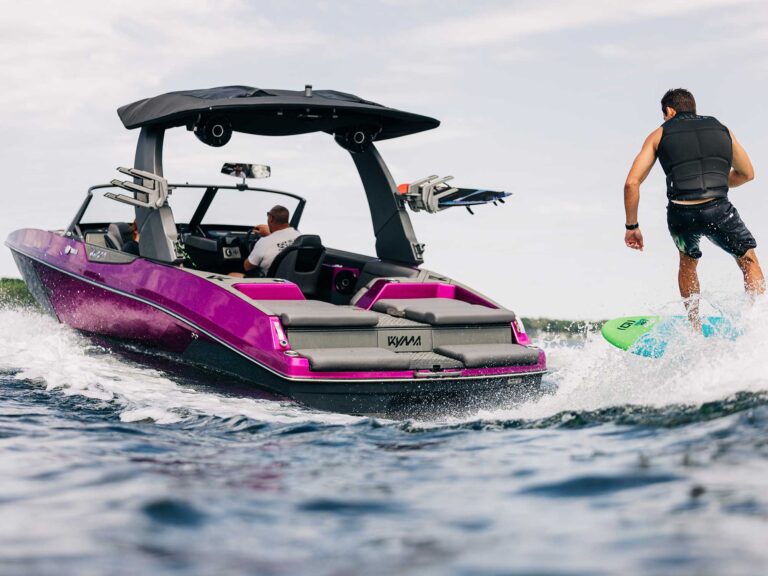
Boat Test: 2024 KYMA K7 Supercharged
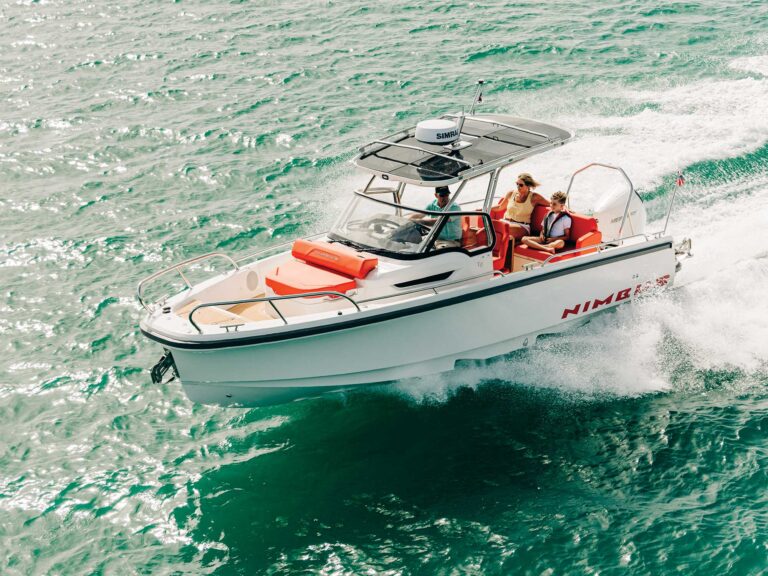
Boat Test: 2024 Nimbus T8

Princecraft Launches the All-New Sport 188

- Digital Edition
- Customer Service
- Privacy Policy
- Terms of Use
- Cruising World
- Sailing World
- Salt Water Sportsman
- Sport Fishing
- Wakeboarding
Many products featured on this site were editorially chosen. Boating may receive financial compensation for products purchased through this site.
Copyright © 2024 Boating Firecrown . All rights reserved. Reproduction in whole or in part without permission is prohibited.

Service Locator
- Angler Endorsement
- Boat Towing Coverage
- Mechanical Breakdown
- Insurance Requirements in Mexico
- Agreed Hull Value
- Actual Cash Value
- Liability Only
- Insurance Payment Options
- Claims Information
- Towing Service Agreement
- Membership Plans
- Boat Show Tickets
- BoatUS Boats For Sale
- Membership Payment Options
- Consumer Affairs
- Boat Documentation Requirements
- Installation Instructions
- Shipping & Handling Information
- Contact Boat Lettering
- End User Agreement
- Frequently Asked Questions
- Vessel Documentation
- BoatUS Foundation
- Government Affairs
- Powercruisers
- Buying & Selling Advice
- Maintenance
- Tow Vehicles
- Make & Create
- Makeovers & Refitting
- Accessories
- Electronics
- Skills, Tips, Tools
- Spring Preparation
- Winterization
- Boaters’ Rights
- Environment & Clean Water
- Boat Safety
- Navigational Hazards
- Personal Safety
- Batteries & Onboard Power
- Motors, Engines, Propulsion
- Books & Movies
- Cockpit Confessions
- Communication & Etiquette
- Contests & Sweepstakes
- Colleges & Tech Schools
- Food, Drink, Entertainment
- New To Boating
- Travel & Destinations
- Watersports
- Anchors & Anchoring
- Boat Handling
Do I Really Need To Winterize?
Advertisement
If you look at the most recent GEICO | BoatUS Marine Insurance winterizing claims analysis over the last 10 years, the answer is a resounding 'yes'.
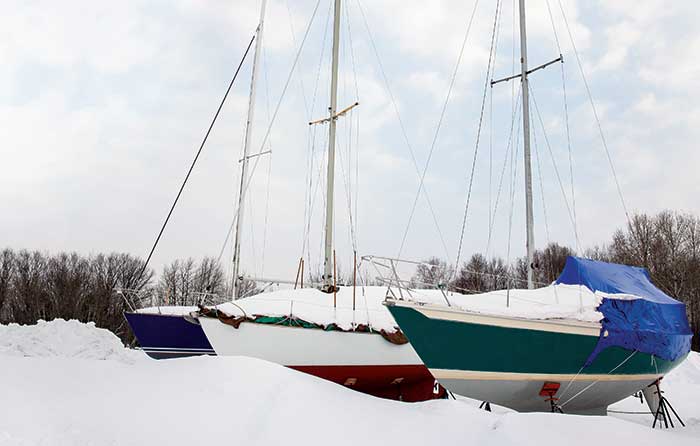
Photo: Getty Images/James Pintar
If you're like most people, you probably think the colder states would have the most claims, but the GEICO | BoatUS Marine Insurance claims files show that the Lone Star State of Texas leads the pack with more than seven times the freeze-damage claims as frigid Minnesota. Even balmy Florida has more claims than Minnesota. Why? Likely because boaters in the frozen North know they need to winterize, so their freeze claims almost always involve a problem with how the boat was winterized (something was missed) or the owner waited too long. In the temperate South, our files include many more claims where the boat wasn't winterized at all, or where the boater was depending on a heater to keep the engine from freezing and the electricity went out.
If you live in a temperate state and aren't sure if you should winterize, look at the list below showing which states have the most freeze damage insurance claims over the last 10 years. More than half of them would be considered warm-weather states, and only Hawaii routinely has no claims. The most freeze claims over the past decade were in 2018 because of a severe winter that included snow in Las Vegas, record cold for Los Angeles, and at one point, nearly half the U.S. experiencing temperatures below freezing. There is no way to accurately predict how cold winter will be in your state, so don't get caught off guard this year.
Top 10 States For Winterizing Claims
1. Texas 2. New York 3. New Jersey (tie) 3. Maryland (tie) 5. Virginia 6. Mississippi 7. Georgia 8. North Carolina 9. Washington 10. South Carolina
What Is Winterizing?
Before the mercury dips below freezing, you need to prepare your boat for the coming winter. At its most basic, winterizing means draining any water aboard or replacing it with enough of the right kind of antifreeze to protect against the lowest temperatures your boat might experience. Freshwater expands in volume by about 9% when it freezes and can push outward with a force of tens of thousands of pounds per square inch. That expansion can crack an engine block, damage fiberglass, split hoses, or destroy a refrigeration system overnight. Our analysis of 10 years of freeze claims found that more than three-quarters involved cracks in the engine block or the exhaust manifolds that occurred because water remained in the engine or cooling system during a hard freeze. Not surprisingly, those repairs are expensive and time-consuming.
Visit BoatUS.com/Winterizing to download a copy of our boat winterization guide and checklists, and to read more helpful winterization articles.
Most of those who don't winterize, or don't winterize properly, only find out something is wrong in the spring when brown froth starts spewing through a crack in the side of the engine block, or what looks like chocolate milk appears on the dipstick. Repairing freeze damage takes time and all too often involves a complete engine replacement. By the time the boat is in working order, a good part of the boating season will have been lost. Winterizing most boats takes from an hour to a day. So unless your boating takes places in Hawaii, we recommend winterizing your boat if there will be any time that it could possibly freeze, to minimize the chances that a sudden freeze will put it out of commission next season.
Engines tend to take the brunt of the damage from freezing weather, so they should be your focus. Winterizing engines means draining the water from the engine or replacing it with antifreeze. Mistakes in this step lead to the vast majority of the freeze claims in the our insurance files. Exactly how this is done varies.
How To Winterize Your Boat's Freshwater System
In freshwater-cooled engines, there are actually two systems: a raw-water side that cools the coolant/water mixture (freshwater) in a closed-loop system, which cools the engine. Winterizing the freshwater side simply involves making sure its year-round permanent antifreeze is an adequate mixture to meet the manufacturer's recommendations for your locality — typically a 50/50 mix with water. The preferred technique for the raw water side of inboard engines is circulating special winterizing antifreeze throughout the cooling system. It is far less likely to result in freeze damage as long as the engine is run long enough to circulate the antifreeze to every part of the cooling system.
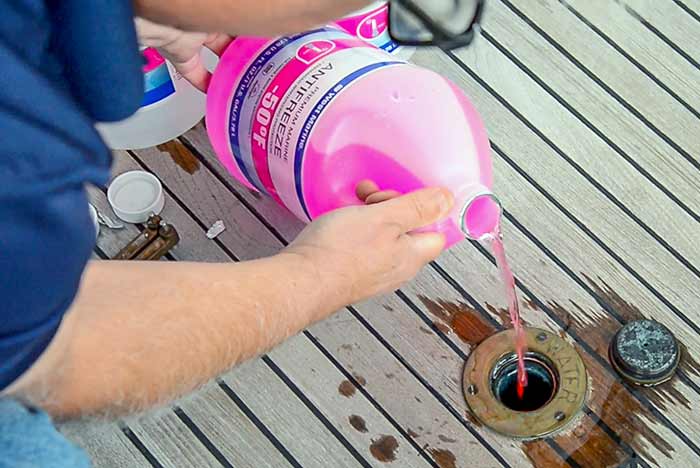
Photo: Stacey Nedrow-Wigmore
Antifreeze is antifreeze, right? Wrong. Not only are there different kinds, the temperature at which they freeze is different, too. And that's important because, if they do freeze, your boat is likely to be damaged.
Antifreeze for winterizing engines and freshwater systems is not the same as the coolant you put in your engine's heat exchanger (the boat equivalent of a radiator). Ethylene glycol, the chemical used in coolant, is highly toxic, so winterizing antifreeze must be nontoxic because it goes in drinking water systems and may eventually go overboard. The antifreeze you use in your engine and plumbing systems must also have the proper freeze protection to keep your systems safe at the lowest possible temperatures your boat may face.
For drinking water and raw water systems, choose antifreeze that contains propylene glycol, which is safe and doesn't have a taste, and one that has rust inhibitors for engine protection. Most importantly, check the freeze rating, but be aware that the numbers used don't correspond to what you may think. A typical antifreeze labeled for -50 F will only protect PVC water pipes from bursting down to about -10 F and will actually begin freezing at about 15 F. At -50 F, it's a solid chunk of ice, capable of cracking an engine block. Play it safe and use an antifreeze that is rated well below any temperature you're likely to experience.
Most winterizing antifreeze must be used full strength — don't dilute. When pumping antifreeze into your engine or freshwater systems, don't shut down as soon as you see the antifreeze come out of the faucet or engine exhaust. The antifreeze first mixes with the water already in the system and has to displace all of it before the antifreeze can protect fully. It's better to invest in a couple of extra gallons than end up with a cracked block at the beginning of next season.
Sterndrives
There are different types of sterndrives, so check your manual for winterizing specifics. Some inboard/outboard (I/O) engines take in cooling water from a thru-hull in the engine compartment, and some take it in through the outdrive. With I/Os that use a thru-hull, the outdrive will be protected once the engine has had antifreeze run through it because the antifreeze also runs through the outdrive. Other models may require the use of "muffs" to first flush and then run antifreeze through the drive. Afterward, all outdrives should be stored in the down position to prevent water from entering the exhaust hub of the propeller. In cold weather, any accumulated water in the outdrive can freeze, and ice may expand and crack the housing.
Electric Heaters Are No Substitute For Winterizing!
Numerous freeze claims over the years have proven the point again and again: If you're tempted to leave your boat with a heater running this winter rather than winterizing, consider these examples:
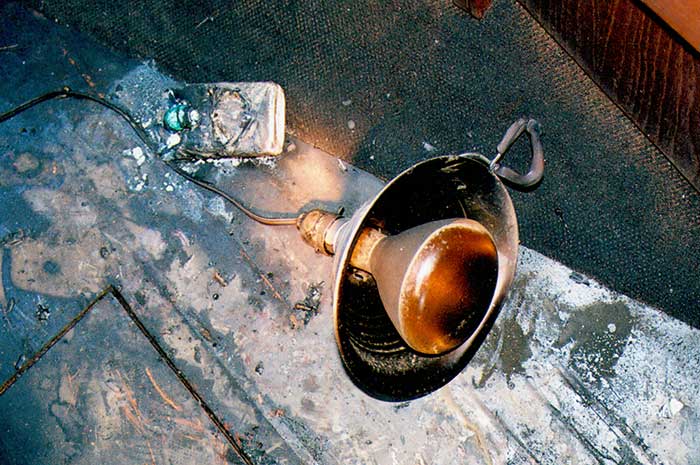
An unattended heat lamp totally destroyed this boat. Photo: GEICO | BoatUS Marine Insurance
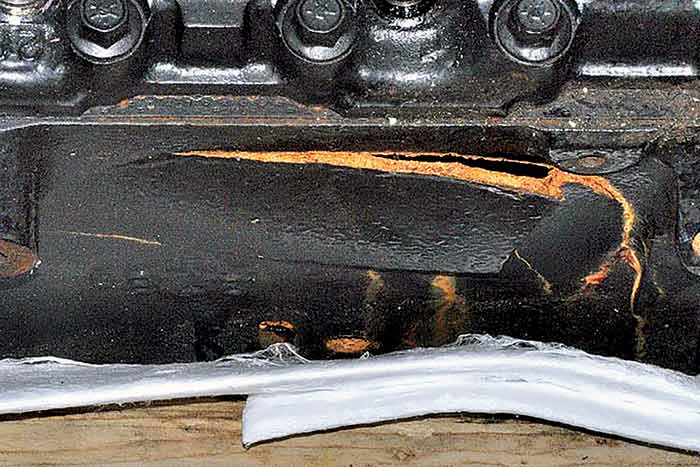
Failure to winterize caused this engine block to crack. Photo: GEICO | BoatUS Marine Insurance
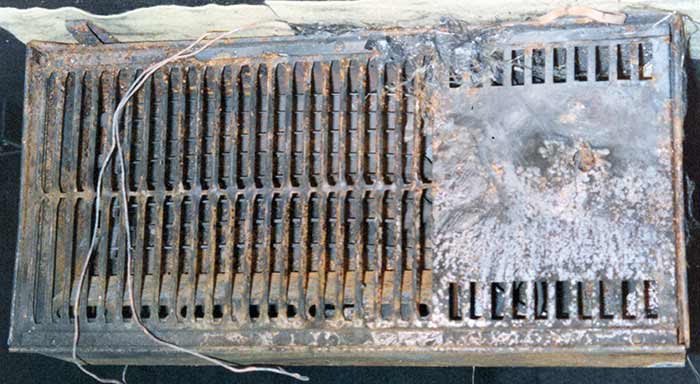
Heaters are poor substitutes for proper winterizing and can start a fire. Photo: GEICO | BoatUS Marine Insurance
The owner of a 24-foot Bayliner in Portland, Oregon, never got around to winterizing his twin gas engines and instead put a heater in the engine compartment. Like a lot of other people, the owner probably didn't think about the fact that power outages most often occur right when you need electricity most — when the worst winter weather hits. An ice storm came through just before Christmas, downing power lines and cutting off power to the heater long enough to freeze the water in the blocks.
A 27-foot Rinker was "winterized" by placing a space heater in the engine room. The boat, which was afloat in her slip in Alabama, caught fire when the extension cord used to power the heater shorted where it had old damage. The boat was destroyed, and it damaged another boat as well as the dock.
Consult your engine's owners manual or service manual before beginning. Today's engines (especially four-stroke and direct-injected two-stroke outboards) may have special winterizing, flushing, and maintenance instructions; follow them closely. The engine should be flushed according to manufacturer's instructions. Sometimes, this doesn't involve running the engine; newer engines have a garden hose fitting allowing for a quick flush without starting the engine.
Other Chores
While most of the GEICO | BoatUS Marine Insurance freeze claims involve the engine or exhaust manifolds, that's not the only place where freezing water can cause serious damage. Plastic plumbing fittings, pumps, and marine heads can all be cracked by ice. Pipes, valves, and pumps in potable water systems can freeze and split open.
As with engines, winterizing the plumbing systems aboard consists of replacing the water with antifreeze. Simply draining the freshwater system isn't enough, as water will almost certainly have pooled somewhere and will freeze over winter. Running antifreeze through the system will ensure that there is no water in the system to freeze. Keep in mind that engine coolant (ethylene glycol) should never be used in a freshwater system as it is very toxic and cannot be reliably purged from the system in the spring.
Once you've taken care of winterizing, visit your boat every few weeks to make sure lines are secure, drains haven't become clogged, bilges are dry, and so on. Checking the boat is especially important after heavy storms or extended cold spells. If you have friends at the marina, arrange to check each other's boats whenever possible.
One more thing our claims files show: Owners who visit their boats over the winter are far less likely to experience problems come spring, which means you'll likely be on the water sooner.
Winterizing Contracts
BoatUS receives complaints every year from boat owners who thought the marina would winterize their boat but the marina didn't do it or didn't know it was supposed to.
Disputes arise when the marina and the boat owner don't have a well-defined contract that spells out exactly what's to be done. The term "winterizing" doesn't have a universal meaning, and your definition of winterizing and theirs may be completely different. Telling someone to winterize the engines and freshwater system doesn't mean they'll also close the seacocks and winterize the head.
If you're hiring someone to winterize your boat, insist on a written contract that clearly lists every job necessary to protect your boat and has a firm time frame, beginning well before the first typical hard freeze. Include language that specifies not to dewinterize until you authorize it in case something comes up and you won't be using the boat through the next winter.
Pay with a credit card if possible. If the boat didn't get winterized properly per the contract and you have damage, you can dispute the charges with your credit card company, which gives you more leverage. Also, don't assume that the marina will routinely inspect your docklines and bilge unless you specifically pay for the service.
Bottom line: Whatever you expect to be done, spell it out in writing.
Related Articles
The truth about ceramic coatings for boats.
Our editor investigates the marketing claims of consumer-grade ceramic coatings.
Fine-Tune Your Side Scan Fishfinder
Take your side-scanning fishfinder off auto mode, and you’ll be spotting your prey from afar in no time
DIY Boat Foam Decking
Closed-cell foam flooring helps make boating more comfortable. Here’s how to install it on your vessel
Click to explore related articles
Charles Fort
Contributing Editor, BoatUS Magazine
Charles Fort is BoatUS Magazine's West Coast Editor. He often writes local news items for BoatUS Magazine's Waypoints column and contributes to Reports, in-depth tech features in every issue written to help readers avoid accidental damage to their boats. He is a member of the National Association of Marine Surveyors, he's on ABYC tech committees, and has a 100-ton U.S. Coast Guard license. He lives in California.
BoatUS Magazine Is A Benefit Of BoatUS Membership
Membership Benefits Include:
Subscription to the print version of BoatUS Magazine
4% back on purchases from West Marine stores or online at WestMarine.com
Discounts on fuel, transient slips, repairs and more at over 1,200 businesses
Deals on cruises, charters, car rentals, hotel stays and more…
All for only $25/year!
We use cookies to enhance your visit to our website and to improve your experience. By continuing to use our website, you’re agreeing to our cookie policy.
- THE PRINCESS PASSPORT
- Email Newsletter
- Yacht Walkthroughs
- Destinations
- Electronics
- Boating Safety
- Ultimate Boating Giveaway

How To Winterize A Boat’s Engines and Generator
- By Lenny Rudow
- September 30, 2022
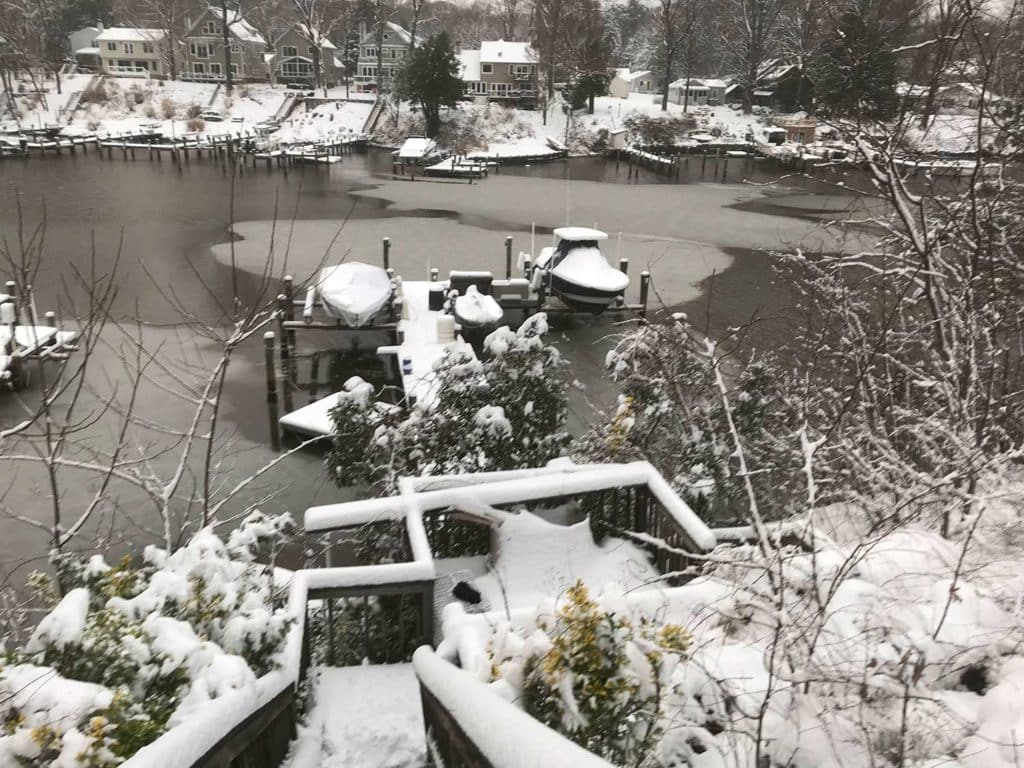
Sure, it’s natural to be a bit depressed when the boating season comes to an end, but keep your chin up and a smile on your face because in a few short months you’ll be ripping away that shrink wrap and prepping for spring again. When that time comes, you’ll want the boat to operate just as smoothly as it did when you put it to bed in the fall, and properly winterizing the engine(s) and generator will ensure that it does.
Whether you’re working on the main propulsion system or a generator (diesel or gasoline), in all cases the boat-winterizing process can be broken down into five steps:
- Stabilize the Fuel System
Change the Fluids
- Drain and/or Winterize the Cooling System
Visually Inspect the Systems
Seal and/or protect any openings to the outside, stabilizing the fuel system.
You’ll want to lay up your boat with full fuel tanks to prevent condensation from forming, however, all fuel has a shelf-life. Over time, varnish and gum can build up in diesel fuel, and gasoline loses octane. If the gas has ethanol in it, the dreaded phase separation can set in too. Adding in a quality fuel stabilizer is key if you want a successful startup come spring. And, after adding it to the tanks be sure to run the engine(s) or generator long enough to allow the treated fuel to work its way all the way through the systems.
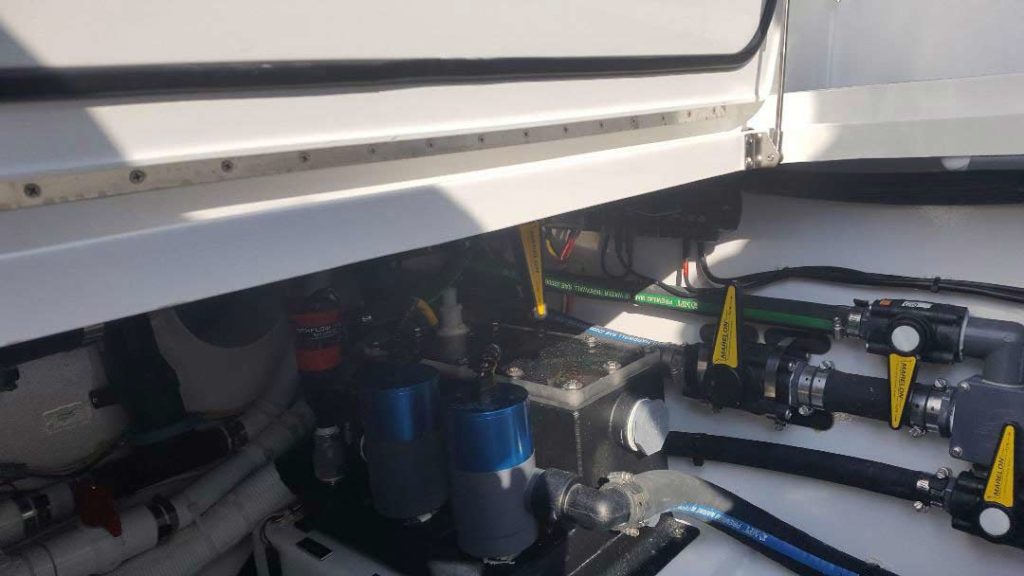
Now’s the time to change the engine’s oils (including lower unit or transmission oil) and, in the case of a closed-cooling system, the coolant as well. All of these fluids deteriorate over time, and with use. Old oil builds up acids and contaminants, and the corrosion-fighting additives in coolants and antifreeze wear thin with age. You’ll want to change all these fluids now, not in the spring, to prevent those contaminants from doing any harm over the winter.
Drain or Winterize the Cooling System
Any engine’s cooling system needs to be completely drained of all water and/or have antifreeze added to prevent freeze damage. Fail to take this step, and the results can be catastrophic. Generally speaking, this will include bringing the engine up to operating temperature and then pulling drain plugs and/or replacing water with antifreeze (excepting outboard engines, which drain fully when tilted all the way down). That said, every manufacturer has its own recommendations for how to perform the task. In some cases, failing to have an authorized dealer perform the winterization may even void the warranty. So, we aren’t going to get into specifics here — you’ll need to refer to the owner’s manual for your particular engine or generator to ascertain exactly what needs to be done.
Prior to putting the boat to bed for winter, take the time to inspect hoses, belts, electrical connections and all the other visible exterior parts on the engines and generators. In fact, now’s the time to inspect all the hoses, wires and other items in the engine room that are subject to aging, whether they’re attached to the engines and generators or not. If there’s a problem like a cracking, aged hose, spot it now and you’ll have plenty of time to have it fixed before the spring rolls around. But if you wait until the weather begins warming back up to perform these basic inspections, the boatyards and mechanics will be busy and it could lead to significant launch delays.
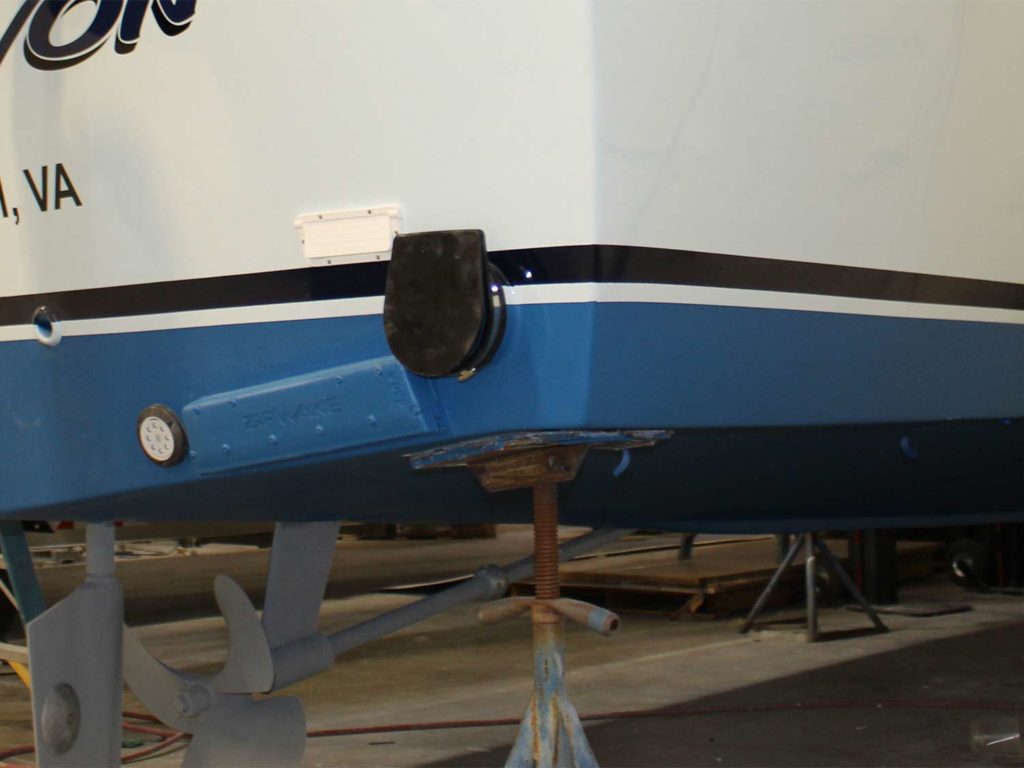
Finally, you’ll want to seal exterior openings like exhaust ports and water intakes (most people simply tape plastic over them and/or tape down flapper valves, if present). This will help keep out moisture, but just as important, it will help keep out critters. Nothing is worse than getting ready for a spring shakedown cruise only to discover a nest of wasps or a family of mice has decided to take up residence inside your boat.
Winterize your engines and generator properly and come spring you should be back out on the water in no time. That alone should be enough to keep a smile on your face all winter long.
- More: Boat Maintenance Tips , Engine Maintenance , Gear , How To , Maintenance

Helly Hansen’s Crew 2.0 Midlayer Jacket

Octoport’s Carbon-Fiber Yacht Furniture Elevates Life Onboard
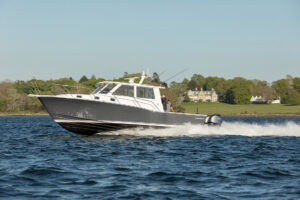
Newport Boat Show Announces New-Product Winners
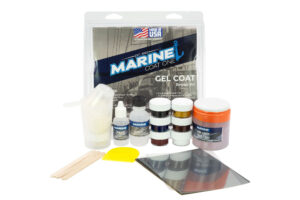
How To Repair Minor Fiberglass Damage on Your Boat
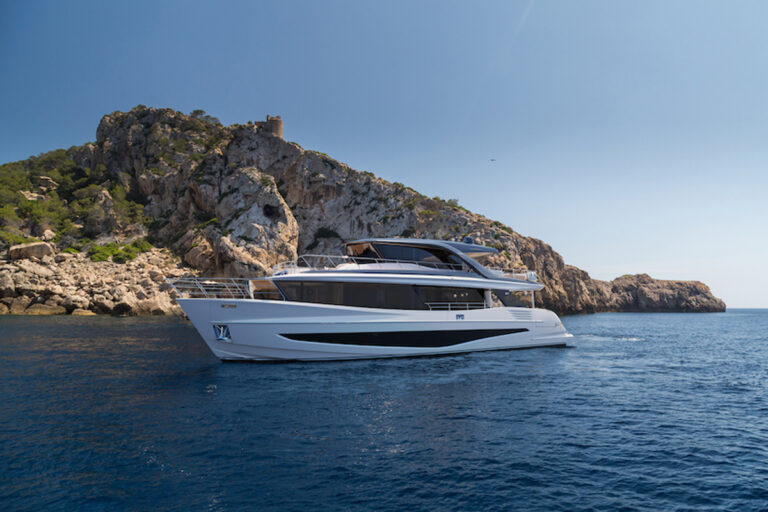
Princess Yachts Unveils the X90

Superyacht For Sale: 141-Foot Christensen

Understanding AIS Technology for Safer Cruising

Shallow-Draft Luxury: Inside Bob Book’s Heesen Superyacht “Book Ends”

- Digital Edition
- Customer Service
- Privacy Policy
- Terms of Use
- Email Newsletters
- Cruising World
- Sailing World
- Salt Water Sportsman
- Sport Fishing
- Wakeboarding

Please verify you are a human
Access to this page has been denied because we believe you are using automation tools to browse the website.
This may happen as a result of the following:
- Javascript is disabled or blocked by an extension (ad blockers for example)
- Your browser does not support cookies
Please make sure that Javascript and cookies are enabled on your browser and that you are not blocking them from loading.
Reference ID: 2bc0d545-8cf2-11ef-b938-e81e21a769ff
Powered by PerimeterX , Inc.

IMAGES
VIDEO
COMMENTS
Winterizing your sailboat involves several steps, but first, you have to gather all the needed supplies. Then, you can proceed with draining the water system, removing the sails and rigging, protecting the boat's engine, and lastly, inspecting and cleaning the boat's interior and exterior.
There are two methods of winterizing a raw-water-cooled engine or the raw-water side of a freshwater-cooled engine: draining the system and leaving it dry, or filling it with winterizing antifreeze (propylene glycol).
Winterizing your boat is essential to protect it from the elements and ensure it's in top condition when spring rolls around. Whether you're learning how to winterize an outboard engine, store a boat for winter, or prepare plumbing systems for freezing temperatures, this guide will walk you through every step.
Winterizing your boat includes draining all water from the boat, adding antifreeze to the engine and plumbing systems, and removing all electronics and batteries. Fill up your fuel tanks and add a fuel stabilizer to prevent the fuel from degrading over the winter.
Winterizing an inboard engine installation means a lot more than filling the cooling system with antifreeze and stuffing a rag in the exhaust outlet. It means taking care of the exhaust system, the fuel system, the engine controls, and other components of the drive train, such as the shaft and prop.
Learn how to winterize a boat using these top tips. Our cheat sheet will make winterizing your boat easy, and keep it protected through winter until it's ready for launch in spring.
At its most basic, winterizing means draining any water aboard or replacing it with enough of the right kind of antifreeze to protect against the lowest temperatures your boat might experience.
The key to a successful spring launch with a boat or yacht, is to properly winterize the vessel's fuel systems for the winter season. Here are some tips to help boat owners winterize their boats' fuel systems and ensure a timely launch when the weather warms up.
Prevent costly freeze damage by properly winterizing your diesel engine or genset. Visit West Marine for a walkthrough on how to get the job done right
Winterizing your boat, can be fairly easy and straightforward, or very detailed, costly and complex, depending on the size, features and onboard equipment. Not to mention your location and the tyoes of boat storage options available to you.